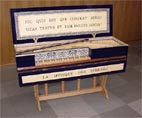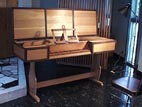Flemish Virginal

Compass: AA - d'''
Size: 1520mmW x 482mmD x 202mmH
Reference: Drawings by Edward R. Turner, 1977
Model: Joannes Ruckers, 1629: The Brussels Museum of Musical Instruments
# 2511
The compass of the original instrument is between C/E and d'''. The
original instrument is said to be strung to sound a major third above the modern
pitch, a'=554Hz, (Grant O'Brien, 1977). Sounding length of this instrument has
been modified to best fit with the normal baroque pitch (a'=415Hz) and the
low end of the compass was stretched to AA. The size of the body has been
adjusted to cope with these modifications, as well.







![]()
![]()
Italian Virginal 
Compass: HH - c'''
Size: 1644mmW x 485mmD x 181mmH
Reference:
1. Drawings and instructions by Denzil Wraight
2. Italian Harpsichord Building in the 16th and 17th Centuries by John D.Shortridge
Model: Marco Jadra, 1552
The original instrument is kept in the Pitt-Rivers Museum in Oxford. Like an above mentioned Italian harpsichord, an Italian
virginal is also often kept in an outer case. The basic structure and material are common with those of Italian harpsichord.
The side boards do not seem to be as thin as the actual thickness, due to the molding, glued on the top edge of the
surrounding side boards as reinforcement. Virginal was loved in UK, in particular, and a number of pieces were composed
for this instrument. Below, an excerpt from an article by John D. Shortridge, which characterizes the Italian instrument very
well:
"Their instruments of the mid-16th century hardly can be distinguished from those made around 1700. During
this 150 years the pioneering Flemish makers added the four-foot register, a second keyboard, and lute and
buff stops to their instruments. However, the very fact that the Italian builders were unwilling to change their
models suggests that their instruments were good enough to demand no further improvements. "